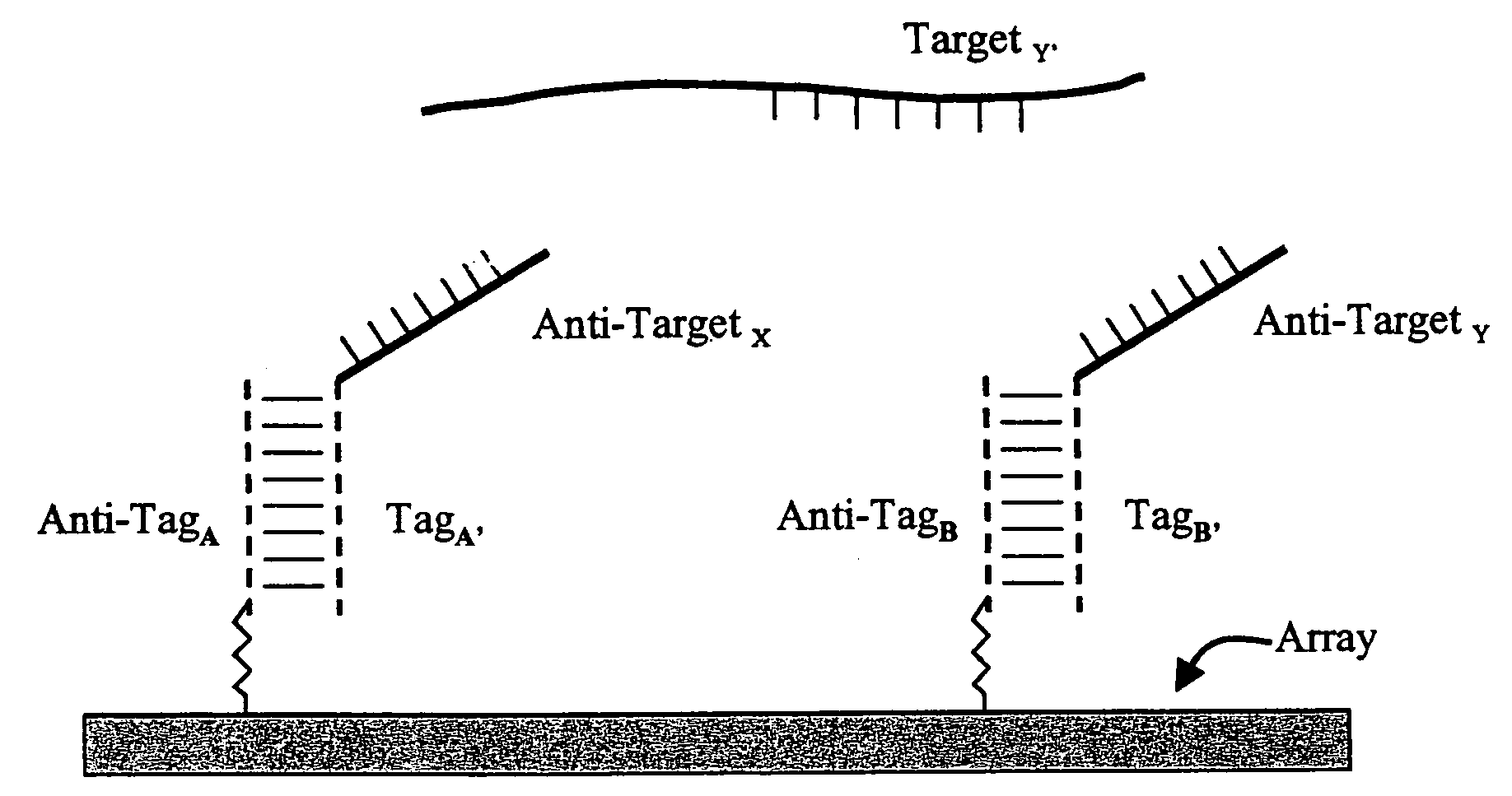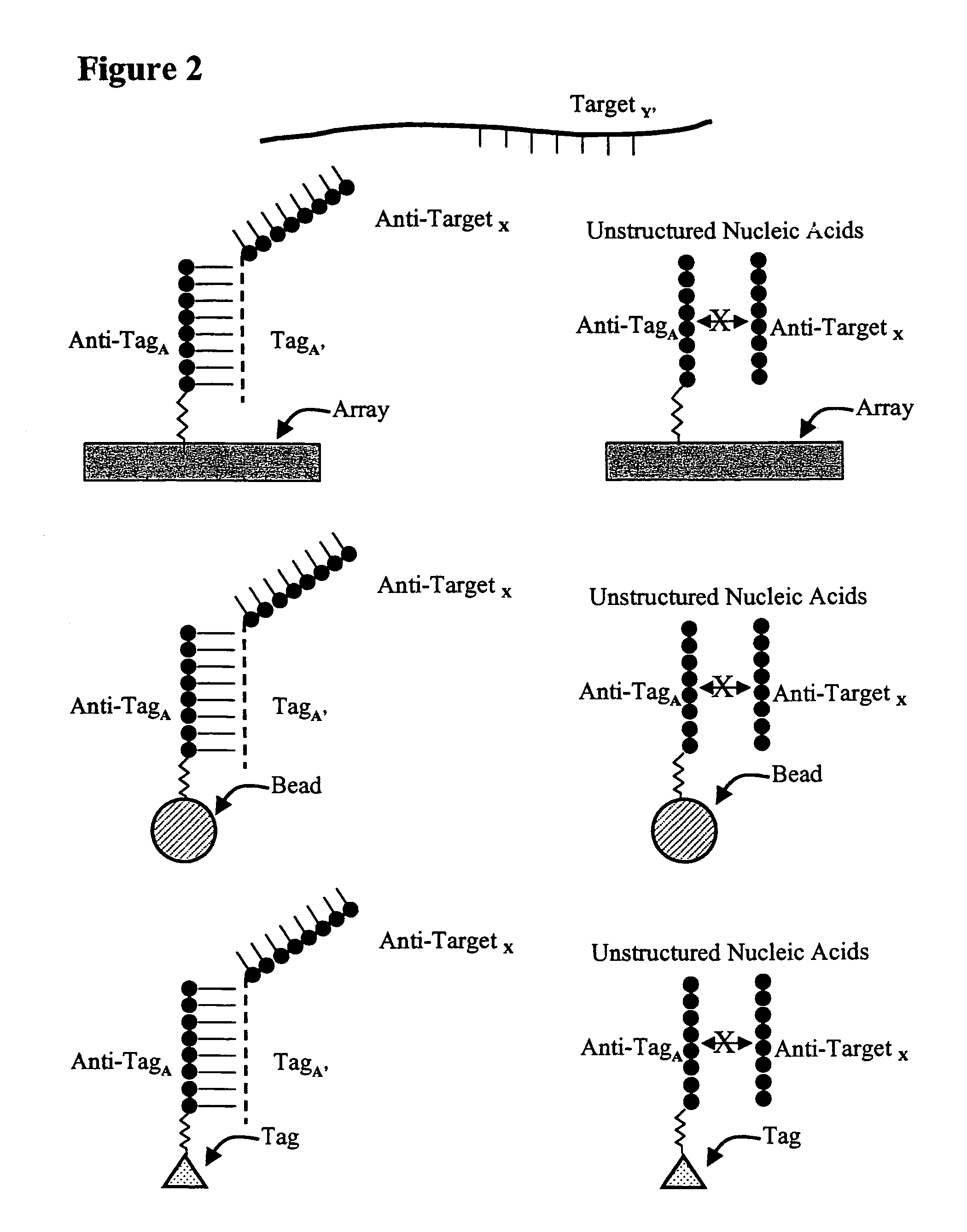Use of unstructured nucleic acids in assaying nucleic acid molecules
a nucleic acid and nucleic acid technology, applied in the field of nucleic acid analysis and nucleic acid biochemistry, can solve the problems of reducing the sensitivity and selectivity of the assay, introducing background signals, limiting the power of the assay, etc., and achieves reduced background signals, increased sensitivity and specificity, and reduced background signals
- Summary
- Abstract
- Description
- Claims
- Application Information
AI Technical Summary
Benefits of technology
Problems solved by technology
Method used
Image
Examples
example 1
Incorporation of the 2-amino-2′-deoxyadenosine-5′-triphosphate and 2-thiothymidine-5-triphosphate into Polynucleotides by DNA Polymerases
[0098]The ability of the Bacillus sterothermophilus (Bst) DNA polymerase (New England Biolabs), the Thermus aquaticus (Taq) DNA polymerase (Amersham) and the Moloney Murine Leukemia Virus reverse transcriptase (MMLV-RT) (Amersham) to incorporate the dDTP and 2-thioTTP into polynucleotides was tested using a synthetic 30-mer template and 32P-labeled 12-mer primer (S.A. 130 Cl / mmol). (FIG. 4). Extension reactions for each polymerase were performed in 0.65 ml pre-siliconized microfuge tubes containing the following components: (Bst) 20 mM Tris-Cl (pH 8.8 @25° C.), 10 mM KCl, 10 mM (NH4)2SO4, 2 mM MgSO4, 0.1% Triton-X100, 0.5 microM primer / template, 250 microM each dNTP and 0.15 units / microL Bst DNA polymerase; (Taq) 26 mM Tris-Cl (pH 9.5 @25° C.), 6.5 mM MgCl2, 0.5 microM primer / template, 250 microM each dNTP and 0.15 units / microL Taq DNA polymerase; ...
example 2
Synthesis of Single Stranded Polynucleotides
[0104]Unstructured single stranded UNA was generated by incorporating 2-aminoadenosine and 2-thiothymidine nucleotides using a 14-mer primer and 56-mer template (5′-phosphorylated) and Bst DNA Polymerase followed by digestion of the DNA template with Lambda Exonuclease (FIG. 8). Ten microliter extension reactions were performed in 0.65 ml pre-siliconized microfuge tubes containing the following components; 20 mM Tris-Cl (pH 8.8 @25° C.). 10 mM KCl, 10 mM (NH4)2SO4, 2 mM MgSO4, 0.1% Triton®-X100 polyethylene glycol tert-octylphenyl ether (also referred to as t-octylphenoxypolyethoxyethanol), 1.0 microM primer / template, 500 microM dGTP, 500 microM dATP (or dDTP), 500 microM dTTP (or 2-thioTTP), 200 microM 32P-CTP and 0.8 units / microL Bst DNA polymerase. The reactions were incubated at 65° C. for 30 minutes, quenched with 5 mM EDTA, ethanol precipitated, dried and resuspended in 10 microL of 10 mM Tris-Cl pH 8.0. The 56-mer template was diges...
PUM
| Property | Measurement | Unit |
|---|---|---|
| Time | aaaaa | aaaaa |
| Angle | aaaaa | aaaaa |
| Angle | aaaaa | aaaaa |
Abstract
Description
Claims
Application Information
 Login to View More
Login to View More - R&D
- Intellectual Property
- Life Sciences
- Materials
- Tech Scout
- Unparalleled Data Quality
- Higher Quality Content
- 60% Fewer Hallucinations
Browse by: Latest US Patents, China's latest patents, Technical Efficacy Thesaurus, Application Domain, Technology Topic, Popular Technical Reports.
© 2025 PatSnap. All rights reserved.Legal|Privacy policy|Modern Slavery Act Transparency Statement|Sitemap|About US| Contact US: help@patsnap.com



